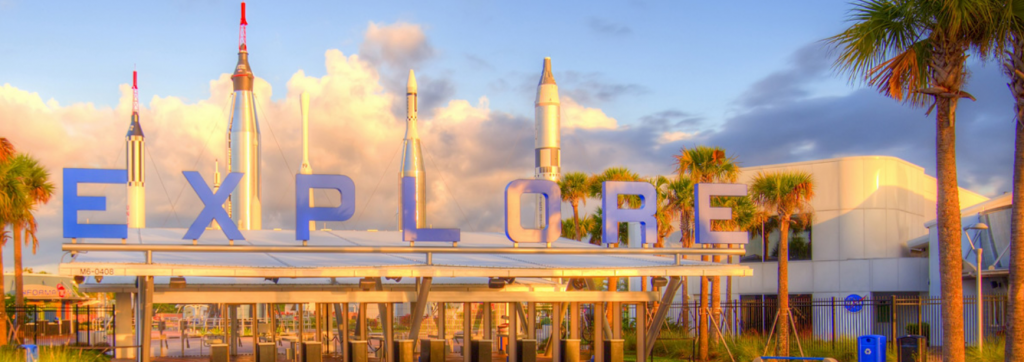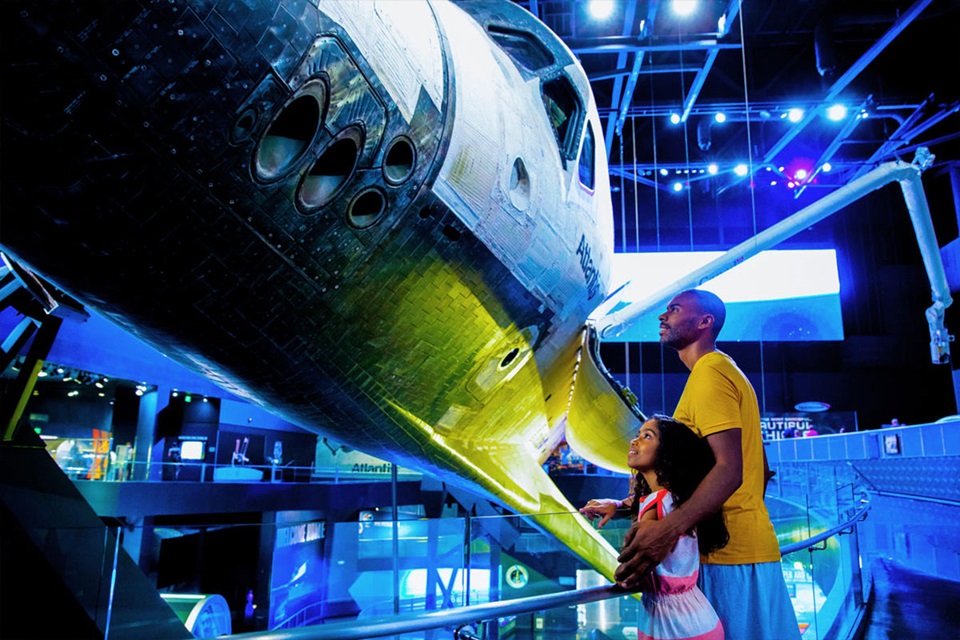
All across the world are Treasures we can go explore. Some are even out of this world! In this Treasures of the Museum series, MW reaches out to museums across the world and asks them Six Questions. It’s inspiring to learn more about these hidden treasures.
What Treasures are in the Museums? What are the interesting stories behind some of the most incredible items? What are some things to look for when we visit?
I was so appreciative, and excited, that Rebecca from the Kennedy Space Center Visitor Complex took time to share answers to these very questions. So much is available for us to experience incredible adventures, and you don’t want to miss out! Let’s learn more about the Kennedy Space Center Visitor Complex and its treasures! Enjoy!
Six Questions with Rebecca:
- 1Q) When did you start working with the Kennedy Space Center Visitor Complex? Can you share some of its historical background?
I started working at the visitor complex in April 2016. I grew up in Titusville (close to KSC) and watched space shuttle launches growing up. The space program has always been a part of my life and it is exciting to work at the visitor complex to share the NASA story with our guests every day.
Historical background:
With word quickly spreading about NASA’s bold Mercury program and the success of Alan Shepard’s historic suborbital launch on May 5, 1961, growing numbers of press and public flocked to the Cape Canaveral area to get a closer look at America’s growing space program. To build on the support and goodwill of the public, a drive-through tour of what was then known as Cape Kennedy, now called Cape Canaveral Air Force Station was offered. On Sunday afternoons from 1 to 4 p.m., the public could drive their own vehicles on a predetermined route that provided a glimpse of the launch pads and facilities.
Despite the limited access, the tours proved immensely popular. Meanwhile, excitement began to build next door at Kennedy Space Center, which had earned its own status as an official space center in 1962, with help from the National Park Service, NASA created a plan to create a Visitor Information Center (VIC), as well as a guided bus tour of the center and its operations which opened on August 1, 1967. It spanned 42 acres and featured examples of Mercury, Gemini, and Apollo hardware, as well as exhibits, two theaters, and concession and souvenir facilities housed within two main buildings.
Today the visitor complex is one of Central Florida’s most popular destinations.
You can read more here: https://www.kennedyspacecenter.com/blog/31/history-of-kennedy-space-center-visitor-complex
- 2Q) What do you enjoy most about working at the museum?
I enjoy seeing the look of excitement and inspiration on our guests’ faces as they see the Rocket Garden for the first time. You begin to understand what amazing feats have been accomplished in the space program. It also remarkable to see the care that is given to priceless artifacts like the Saturn 1B rocket, the Saturn V and space shuttle Atlantis. These projects are entirely visitor-funded. It is an honor to care for them on behalf of NASA.
Being part of an active spaceport is exciting too, with rocket launches occurring regularly, including the first crewed launches since the end of the Space Shuttle Program.
- 3Q) Do you feel there is one exhibit or artifact that the museum is most known for? Can you share some interesting facts about it?
Space Shuttle Atlantis
As NASA’s fourth space-flown shuttle, Atlantis was in service for 26 years and flew 33 missions. With each mission she launched as a rocket, flew as a spacecraft and landed as a glider.
Displayed at 43.21 degree angle – (get it? 4,3,2,1) with cargo bay doors open – as only astronauts have seen her from space. The orbiter looks almost exactly like she did in space during her final flight.
Her portside wingtip is only 7.5 feet off the ground, while her nose is 26.5 feet off the ground.
The attraction also includes a full-scale mockup of the Hubble Space Telescope, another remarkable accomplishment of the Space Shuttle Program.
- 4Q) Is there some often forgotten item that shouldn’t be missed when visiting?
Most of our treasures are “hiding in plain sight”. You might see something and think it is a replica but most items are artifacts. In NASA Now we have the Orion crew vehicle from EFT-1 and a SpaceX Dragon cargo vehicle. It is located in the IMAX building so guests sometimes miss it.
- 5Q) What do you feel is the most valuable ‘treasure’ of the museum? It might not be a monetary value, but of a historical value or even sentimental?
For me, that is space shuttle Atlantis. I grew up watching shuttle launches so I get a great sense of pride seeing this national treasure on display. Each generation of guests reacts differently to artifacts from the programs and that is inspiring to see as well.
The Saturn V Moon rocket, one of only three still in existence and the Saturn 1B, the only flight-configured rocket of this kind, are a close second and third. You get a true sense of the kind of power it took to go to the Moon when you see the Saturn V rocket, it is BIG.
- 6Q) Is there any advice you would have for those wanting to visit? Are there best times of the day, or days of the week to come? How long should visitors allow on their schedules to explore the fascinating exhibits?
Plan to stay a day or more. Most people do not realize how much there is to see and do here so make sure to get here early and plan on staying all day. I also recommend going to Atlantis first, if you arrive in the morning, as it is in the “back” of the visitor complex so you can avoid a crowd.
You don’t want to miss Shuttle Launch Experience, located inside of the Space Shuttle Atlantis attraction.
Right now, our Kennedy Space Center Bus Tour is not available (due to COVID-19). Once it resumes, it takes a day or longer to see everything.
- Bonus Q: ‘Is there an item, a ‘lost treasure’ so to speak, that the Museum is on the lookout for? Might it be out there to find?’
We’re always on the lookout to enhance the guest experience, through new attractions, artifacts and experiences. I would not say there is one specific thing that we are on the lookout for. We will be adding some new treasures to the visitor complex later this year! Follow us on Facebook (Kennedy Space Center Visitor Complex) and Twitter (@ExploreSpaceKSC) to stay up-to-date.
Come explore the Kennedy Space Center Visitor Complex Today!



